The Marvelous Madame Marval: A Woman Artist Among the Fauves
- SUBSCRIBE
- ALREADY SUBSCRIBED?
BECOME A BONJOUR PARIS MEMBER
Gain full access to our collection of over 5,000 articles and bring the City of Light into your life. Just 60 USD per year.
Find out why you should become a member here.
Sign in
Fill in your credentials below.
In his April 5, 1912 article in Le Petit Bleu on women artists, celebrated poet and art critique extraordinare, Guillaume Apollinaire, wrote: “Just as our age has allowed some female talents to blossom in the world of letters, so it has produced a number of female personalities in art that cannot be ignored. During the 1911-12 season, a large number of individual exhibitions have displayed works of art done by women. Never before this winter, either in Paris or elsewhere, has one seen so many women prove that their artistic abilities are in no way inferior to those of men. What women contribute to art is not technical innovations, but rather taste, intuition, and something like a new and joyous vision of the universe.” (Translated by Susan Suleiman, in Apollinaire on Art: Essays and Review, 1902-1918, edited by Leroy C. Breunig, 1972).
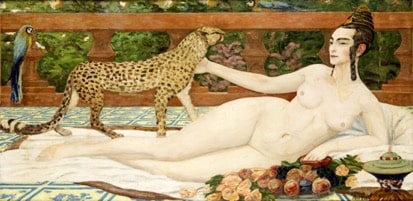
Jacqueline Marval, Odalisque with a Leopard, 1900, oil on canvas, 95 x 192 cm. Salon des Indépendants, 1901, Paris. Former Collection Ambroise Vollard. Former Collection Paul Baignères . Former Collection du Petit-Palais, Genève. Collection Raphaël Roux dit Buisson, Paris.
Highlighting numerous examples in art history and the present, Apollinaire singles out Jacqueline Marval with this praise: “Mme. Marval has offered art-lovers an entirely different kind of treat. This artist has imagination, and a very personal talent. Abstraction is not her strong point, but she has a marvelous ability to reveal the poetic reality of her subjects. . . In her large canvas of odalisques, Mme. Marval has given the measure of her talent and has achieved a work of importance for modern painting. This strong and sensual work, freely painted and wholly personal in composition, line and coloring, deserves to survive.” (Translated by Susan Suleiman)

Jacqueline Marval (1866-1932), au Jardin du Luxembourg, 1905-6.
The second of eight children, Jacqueline Marval was born on October 19, 1866 as Marie-Josephine Vallet in Quaix-en-Chartreuse, near Grenoble, France. Both parents were schoolteachers. Her father was an amateur musician and painter. In 1884 she too became a school teacher and also an amateur painter, exhibiting her work as Marie Jacques. In 1886 she married Albert Valentin, a traveling salesman. However, in 1891 the couple lost their infant son and the marriage unravelled. Marval left her husband and moved to Grenoble, making a living sewing waistcoats. There she met the younger modernist painter Jules Flandrin (1891-1947), born in Corenc, also not far from Grenoble. In 1895, Marval moved to Paris to live with Flandrin, already settled there since 1893. Flandrin studied with École de Beaux-Arts professor Gustave Moreau in his rue de la Rochefoucauld atelier, through 1898, along with classmates Henri Matisse, Albert Marquet, Charles Camoin, Charles Guérin, and Georges Rouault, who became the infamous “fauves” (wild beasts) contingent.
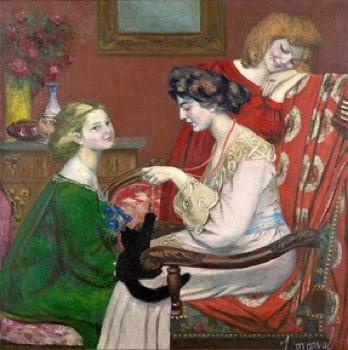
Jacqueline Marval, Les Coquettes, 1903, oil on canvas, 130 x 130 cm. Former collection of Ambroise Vollard. Collection Raphaël Roux dit Buisson, Paris.
A forgotten member of the Fauves, Marval shared their love of bright colors, strong contrasts and sensual subject matter. Her earliest work featured women in various contexts, from cozy domesticity to rather glacial eroticism. There is no doubt that she influenced Jules Flandrin as much as he influenced her. Their stylistic affinities produced a confident sculptural style that emphasized firm contours reminiscent of Renoir’s retreat from Impressionism in the 1880s and 1890s.
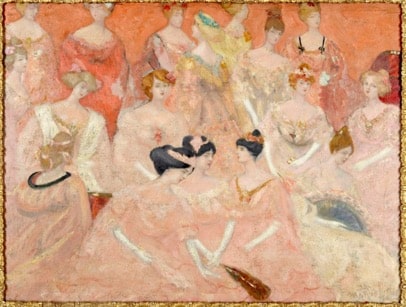
Jacqueline Marval, La Duchesse de Monbazon, 1903, oil on canvas, 100 x 130 cm, Private Collection, Moscow.
“Marval was the glorious explorer of the Fauvism’s virgin forest, where, as a subtle white panther, she led the horde of Fauves– Matisse, Braque, Vlaminck, Dufy, Friesz and van Dongen– on new pathways of a new war against academism. She was the clear and divine agitator of the revolt, which Jules Flandrin brought back to his Grenoble each year during his vacations.” (Andry-Farcy, “Introduction,” Jacqueline Marval, exhibition catalogue, Musée de Beaux-Arts de Grenoble, Paris: Editions Albert Morance, 1929.)
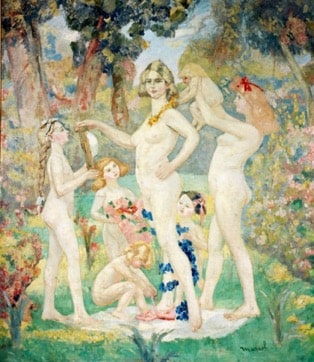
Jacqueline Marval, La Toilette de Printemps, 1907, oil on canvas, 225 x 175 cm, collection Raphaël Roux dit Buisson, Paris.
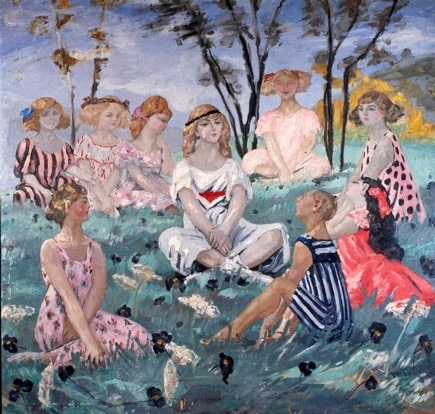
Jacqueline Marval, Sylvie ou la Chant d’Adrienne de Gérard de Nerval, 1912, oil on canvas, 220 x 200 cm, Private Collection, France. (Based on Gérard de Nerval’s short story “Sylvie : Souvenir de Valois,” 1953.)
And yet, as Cubism replaced Fauvism as the avant-garde, bringing into vogue their severe geometric forms, Marval and Flandrin gravitated toward the older, soft-focus Post-Impressionism practiced by Pierre Bonnard and Édouard Vuillard. In Marval’s work particularly we see her shift from crisp, clear radiance to painterly pastels similar to her younger contemporary Marie Laurencin. Not surprisingly, in 1913, Marval, Bonnard, Maurice Denis and the sculpture Antoine Bourdelle joined forces to decorate the new Théatre des Champs-Élysées. (Note that Jacqueline Marval’s contribution is not mentioned.)
During that same year, the artist Francis Picabia invited Marval to participate in the famous New York Armory Show, which traveled to Chicago, exhibiting Odalisques in the Mirror (1911) among a vast array of international modern artworks, mainly from France, in a historic effort to introduce the American public to contemporary trends. Three years later, in 1916, during World War I, the poet/critique André Salmon curated a rather ambitious exhibition called L’Art Moderne en France (a.k.a. Le Salon d’Antin), installed in the Galerie Barbazanges owned by the couturier Paul Poiret. There Marval’s Odalisques (1903) hung next to Pablo Picasso’s Demoiselles d’Avignon (1907), which appeared for the first time outside the Spanish artist’s studio. Salmon’s juxtaposition of the two equally large paintings unleashed a dialogue that amply informed the viewers about the content of Picasso’s strange gathering of Gorgons. For mindful of the censorship that forbid the use of the word “brothel” in a title, Salmon decided to indicate the true circumstances for The Young Ladies from Avignon (the title he invented, based on the licentious reputation of the French city and the street in Barcelona) by placing a private harem next to a western equivalent. Les Odalisques debuted at the Salon des Indépendants in 1903, when Picasso was living in Barcelona. He might have seen the painting in a group show at Galerie Berthe Weill in 1906 or during a studio visit arranged by mutual friends.

Jacqueline Marval, The Bohemian, 1921, oil on canvas, 130 x 200 cm, Private Collection, London.
During World War I, Marval took care of the children of artists who served in the war. In 1917, she moved to 19 Quai St. Michel, where Matisse had lived and worked from 1899 to 1907 and again during the early years of World War I. She also continued to exhibit during the war and more frequently afterwards. Besides support from Galerie Berthe Weill, she exhibited at Galerie Druet, numerous annual Salons, and venues abroad: New York, Chicago, Pittsburgh, Tokyo, London, Zurich, Barcelona, Basel, Oslo, and Stockholm. When Jules Flandrin returned from the front, relations between the artists grew stormy. By 1921, Flandrin become involved with another Grenoble artist living in Paris, Henriette Deloras, whom he married in 1931. Although actively exhibiting, Marval fell on hard times. She ended her days in poverty, succumbing to cancer on May 28, 1932 in the Hôpital Bichat, in Paris.
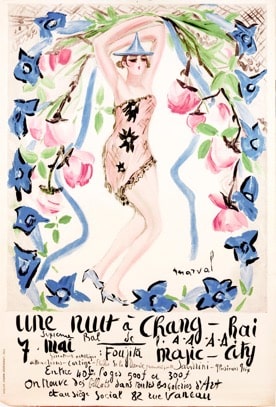
Jacqueline Marval, A Night in Shanghai, The Sixth Bal de l’Aide Amicale Aux Artistes, 1928, lithographie, 122 × 76 cm, collection Raphaël Roux dit Buisson, Paris.
For more information about Jacqueline Marval, please consult the website dedicated to her work: www.Jacqueline-Marval.com, curated by Raphaël Roux Dit Buisson and Camille Roux Dit Buisson, owners of Du Lac Fine Art, Paris. We wish to express our enormous gratitude to Ms. Roux Dit Buisson and M. Roux Dit Buisson for their generous help, cooperation and permission to reproduce the works in their collection.

Jacqueline Marvel, La Clownesse, Portrait of Dolly Davis, 1921, oil on canvas, Musée Marcel Sahut, Volvic.
Lead photo credit : Les Odalisque
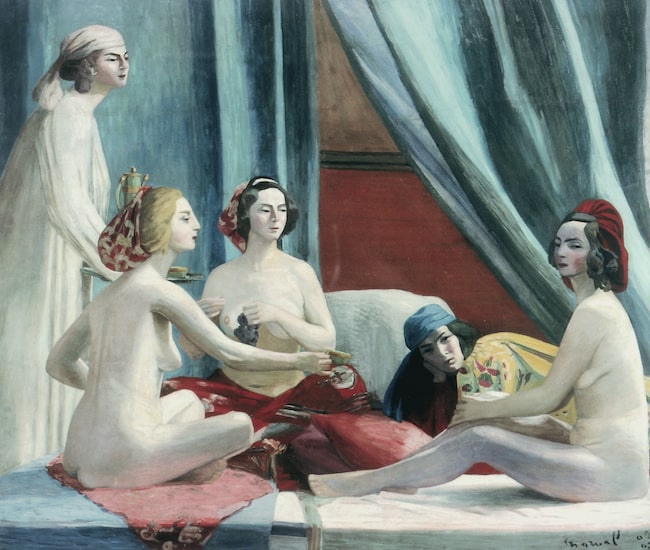




REPLY